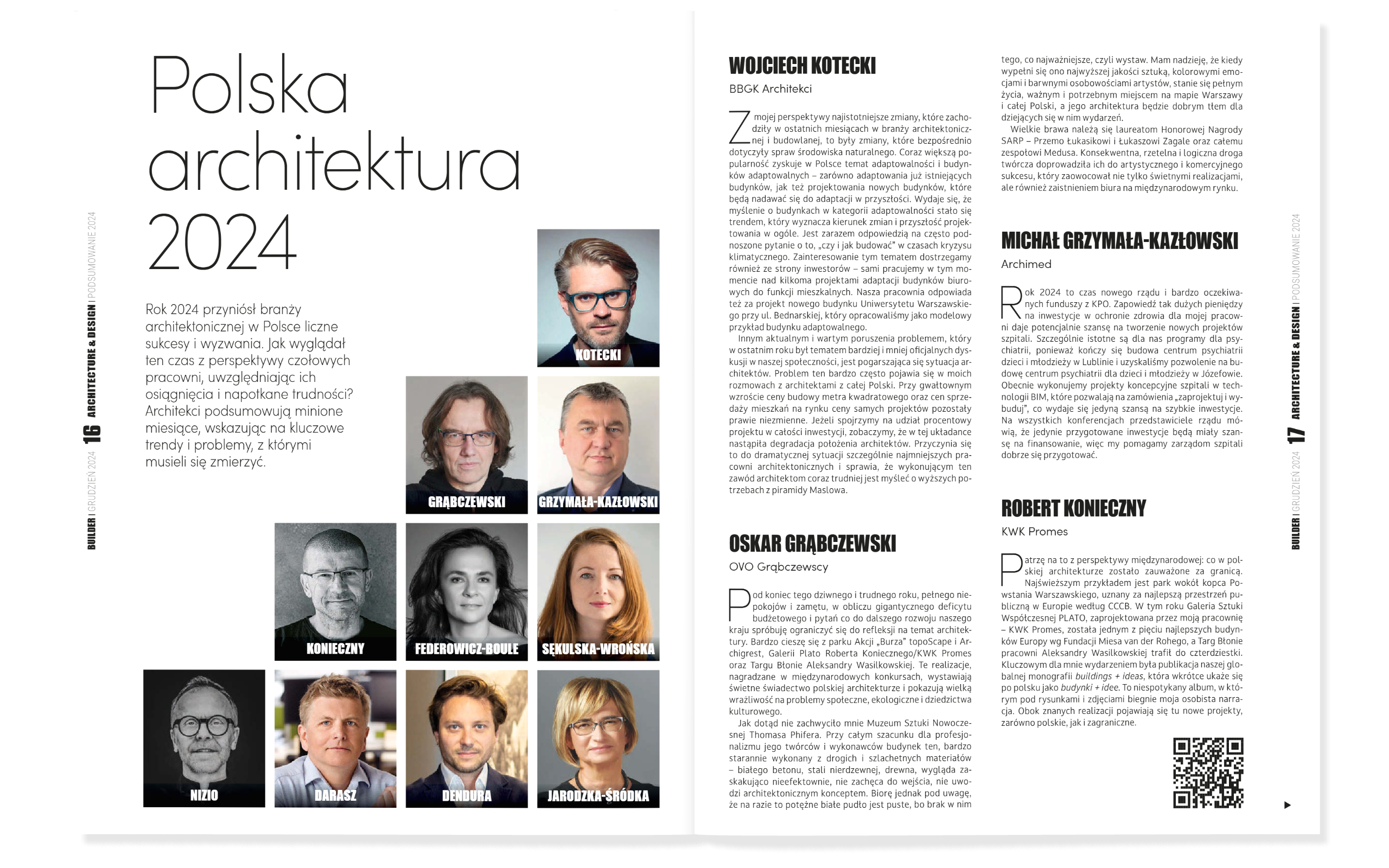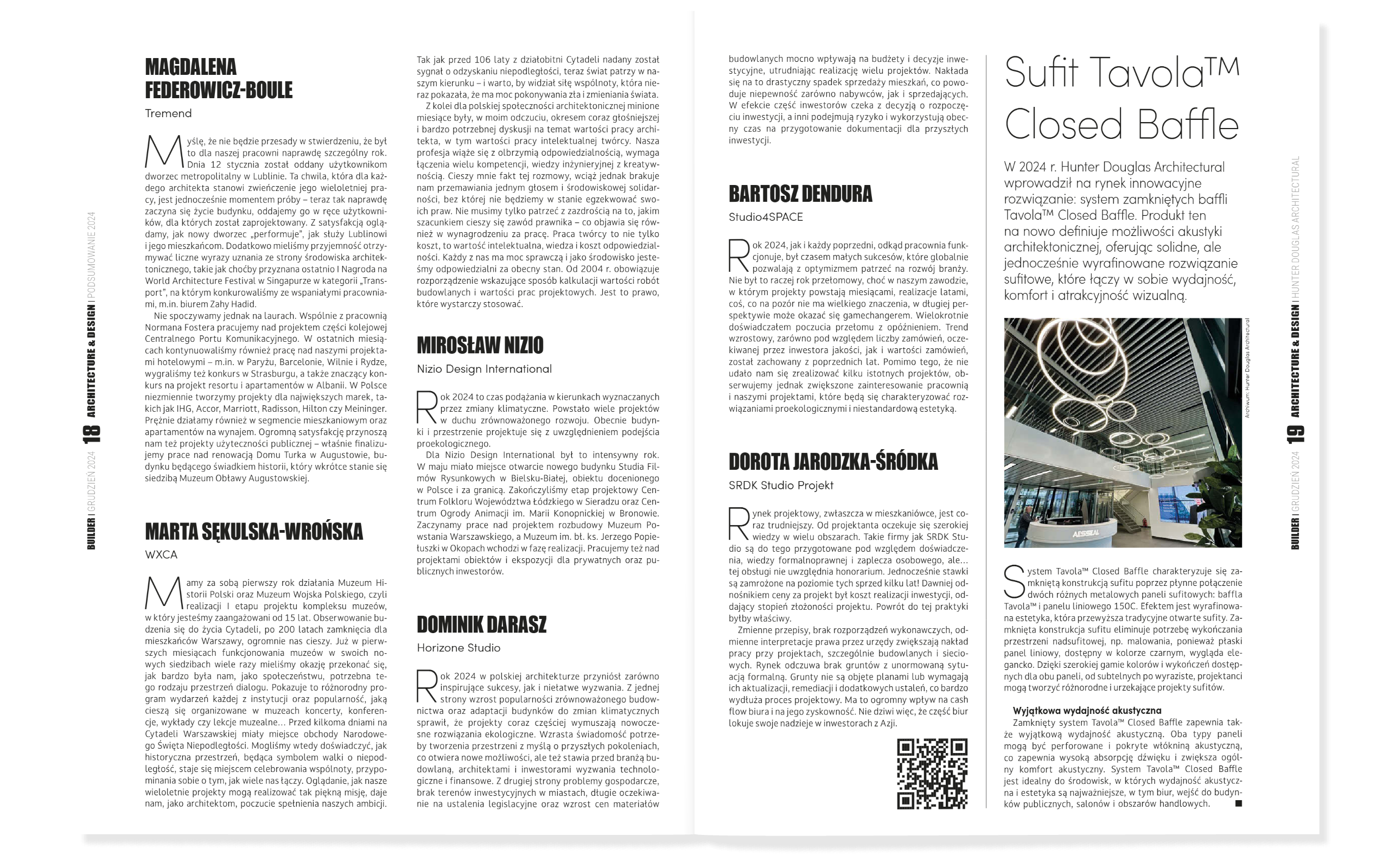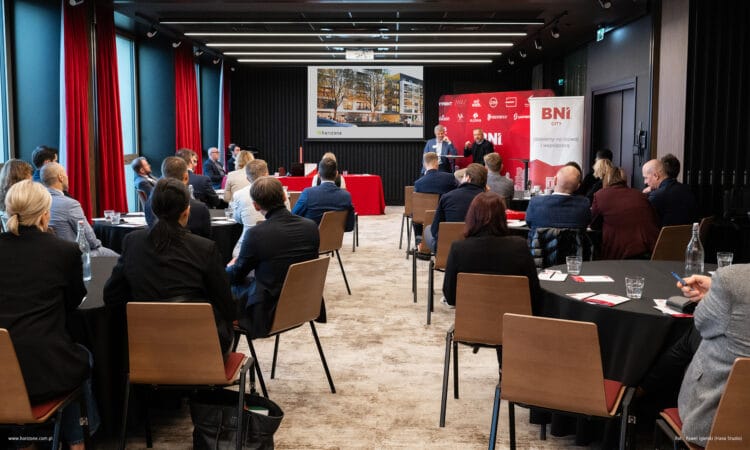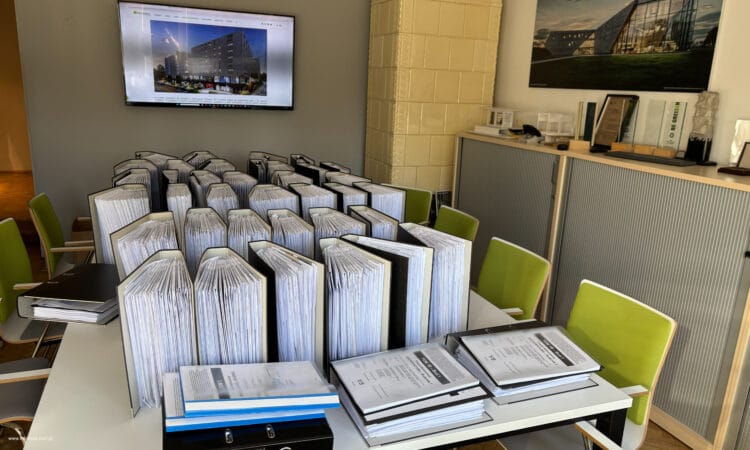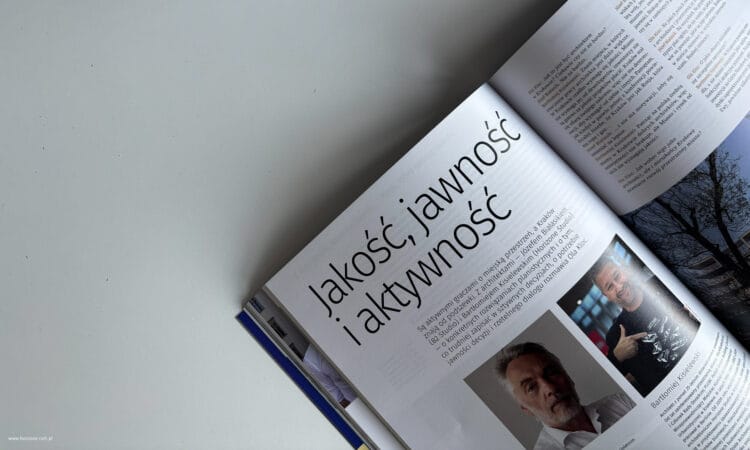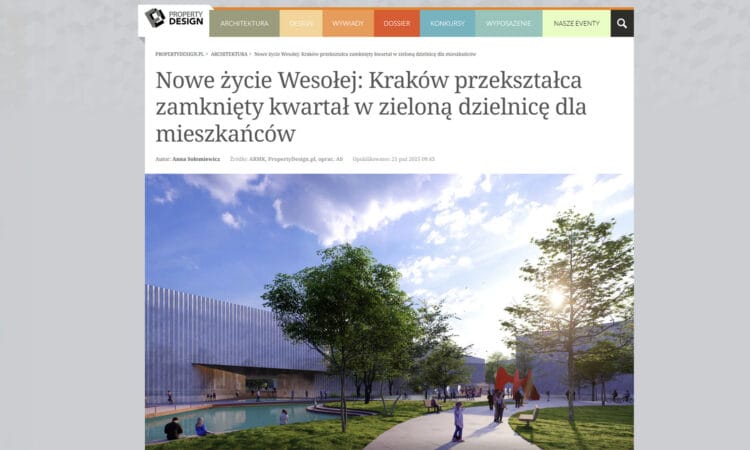WOJCIECH KOTECKI
BBGK Architects
From my perspective, the most important changes that have taken place in the architectural and construction industry in recent months were those that directly concerned environmental issues. The topic of adaptability and adaptable buildings is becoming increasingly popular in Poland – both the adaptation of existing buildings and the design of new buildings that will be suitable for adaptation in the future. It seems that thinking about buildings in terms of adaptability has become a trend that sets the direction of change and the future of design in general. At the same time, it is an answer to the frequently raised question of whether and how to build in times of climate crisis. We also see interest in this topic on the part of investors – we are currently working on several projects to adapt office buildings to residential functions. Our studio is also responsible for the design of the new building of the University of Warsaw on Bednarska Street, which we developed as a model example of an adaptable building. Another current and worthy issue, which has been the subject of more and less formal discussions in our community over the past year, is the deteriorating situation of architects. This problem comes up very often in my conversations with architects from all over Poland. With the rapid increase in the price of construction per square meter and the sale prices of apartments on the market, the prices of the projects themselves have remained almost unchanged. If we look at the percentage share of the project in the total investment, we will see that the position of architects has been degraded in this puzzle. This contributes to the dramatic situation of the smallest architectural studios in particular and makes it increasingly difficult for architects practicing this profession to think about the higher needs of Maslow’s pyramid.
OSKAR GRĄBCZEWSKI
OVO Grąbczewscy
At the end of this strange and difficult year, full of unrest and confusion, in the face of a gigantic budget deficit and questions about the further development of our country, I will try to limit myself to reflections on architecture. I am very happy about the Akcja “Burza” topScape and Archigrest parks, the Plato Gallery by Robert Konieczny/KWK Promes and the Błonie Market by Aleksandra Wasilkowska. These projects, awarded in international competitions, are a great testimony to Polish architecture and show great sensitivity to social, ecological and cultural heritage problems.
So far, I have not been impressed by the Thomas Phifer Museum of Modern Art. With all due respect to the professionalism of its creators and contractors, this building, very carefully made of expensive and noble materials – white concrete, stainless steel, wood, looks surprisingly ineffective, does not encourage entry, does not seduce with its architectural concept. However, I take into account that for now this huge white box is empty, because it lacks what is most important, i.e. exhibitions. I hope that when it is filled with the highest quality art, colorful emotions and colorful personalities of artists, it will become a vibrant, important and necessary place on the map of Warsaw and the whole of Poland, and its architecture will be a good background for the events taking place there.
Big applause is due to the winners of the honorary SARP Award – Przemo Łukasik and Łukasz Zagala and the entire Medusa team. Their consistent, reliable and logical creative path has led them to artistic and commercial success, which has resulted not only in great projects, but also in the presence of the office on the international market.
MICHAŁ GRZYMAŁA – KAZŁOWSKI
Archimed
The year 2024 “is the time of a new government and highly anticipated funds from the KPO. The announcement of such large amounts of money for investments in health care for my studio potentially gives a chance to create new hospital projects. Programs for psychiatry are particularly important for us, because the construction of the child and youth psychiatry center in Lublin is coming to an end and we have obtained a building permit for the child and youth psychiatry center in Józefów. We are currently making conceptual designs for hospitals using BIM technology, which allow for “design and build” orders, which seems to be the only chance for quick investments. At all conferences, government representatives say that only prepared investments will have a chance for financing, so we help hospital boards prepare well.
ROBERT KONIECZNY
KWK Promes
I look at it from an international perspective, which has been noticed abroad in Polish architecture. The most recent example is the park around the Warsaw Uprising Mound, recognized as the best public space in Europe by the CCCB. This year, the PLATO Contemporary Art Gallery, designed by my studio – KWK Promes, was named one of the five best buildings in Europe by the Mies van der Rohe Foundation, and the Błonie Market by Aleksandra Wasilkowska’s studio made it into the top forty. A key event for me was the publication of our global monograph buildings + ideas, which will soon be published in Polish as buildings + ideas. This is an unusual album, in which my personal narrative runs beneath the drawings and photos. Alongside well-known projects, new projects, both Polish and foreign, appear here.
MAGDALENA FEDEROWICZ-BOULE
Tremend
I think it would not be an exaggeration to say that this was a truly special year for our studio. On January 1, the metropolitan train station in Lublin was handed over to users. This moment, which for every architect is the culmination of many years of work, is also a moment of trial – now the life of the building really begins, we hand it over to the users for whom it was designed. We watch with satisfaction how the new station “performs”, how it serves Lublin and its residents. In addition, we had the pleasure of receiving numerous expressions of appreciation from the architectural community, such as the recently awarded 1st Prize at the World Architecture Festival in Singapore in the “Transport” category, where we competed with great studios, including Zaha Hadid’s studio. However, we are not resting on our laurels. Together with Norman Foster’s studio, we are working on the design of the railway part of the Central Communication Port. In recent months, we have also continued working on our hotel projects – including in Paris, Barcelona, Vilnius and Riga, we also won a competition in Strasbourg, as well as a significant competition for the design of a resort and apartments in Albania. In Poland, we consistently create projects for the largest brands, such as IHG, Accor, Marriott, Radisson, Hilton and Meininger. We are also active in the residential and apartment rental segment. Public utility projects also bring us great satisfaction – we are currently finalizing work on the renovation of the Turk’s House in Augustów, a building that is a witness to history, which will soon become the seat of the Augustów Roundup Museum.
MARTA SĘKULSKA – WROŃSKA
WXCA
We have the first year of operation of the Museum of Polish History and the Polish Army Museum behind us, i.e. the implementation of the first stage of the museum complex project, in which we have been involved for 15 years. Watching the Citadel come to life after 200 years of being closed to the residents of Warsaw, makes us very happy. Already in the first months of the museums operating in their new locations, we had many opportunities to see how much we, as a society, needed this type of space for dialogue. This is shown by the diverse programme of events of each institution and the popularity of concerts, conferences, lectures and museum lessons organised in museums… A few days ago, the Warsaw Citadel hosted celebrations of the National Independence Day. We were then able to experience how a historical space, a symbol of the fight for independence, becomes a place for celebrating community, reminding ourselves of how much we have in common. Watching our long-standing projects accomplish such a beautiful mission gives us, as architects, a sense of fulfillment of our ambitions. Just as 106 years ago, the signal about regaining independence was given from the Citadel’s cannon tower, now the world is looking in our direction – and it is worth it for them to see the strength of the community, which has shown more than once that it has the power to overcome evil and change the world. For the Polish architectural community, in turn, the past months have been, in my opinion, a period of increasingly loud and much-needed discussion about the value of an architect’s work, including the value of the creator’s intellectual work. Our profession is associated with enormous responsibility, it requires combining many competences, engineering knowledge with creativity. I am pleased that this conversation is taking place, but we still lack speaking with one voice and community solidarity, without which we will not be able to enforce our rights. We don’t have to look with envy at the respect that the legal profession enjoys – which is also reflected in the remuneration for work. The work of a creator is not only a cost, it is intellectual value, knowledge and the cost of responsibility. Each of us has the power to make things happen and as an environment we are responsible for the current state. Since 2004, a regulation has been in force indicating the method of calculating the value of construction works and the value of design works. This is a law that just needs to be applied.
MIROSŁAW NIZIO
Nizio Design International
The year 2024 is a time to follow the directions set by climate change. Many projects have been created in the spirit of sustainable development. Currently, buildings and spaces are designed with a pro-ecological approach in mind.
It was an intense year for Nizio Design International. In May, the new building of the Animated Film Studio in Bielsko-Biała was opened, a facility appreciated in Poland and abroad. We have completed the design phase of the Łódź Province Folklore Centre in Sieradz and the Maria Konopnicka Animation Gardens Centre in Bronów. We are starting work on the expansion project for the Warsaw Uprising Museum, and the Blessed Father Jerzy Popiełuszko Museum in Okopy is entering the implementation phase. We are also working on designs for facilities and exhibitions for private and public investors.
DOMINIK DARASZ
Horizone Studio
The year 2024 in Polish architecture has brought both inspiring successes and difficult challenges. On the one hand, the growing popularity of sustainable construction and the adaptation of buildings to climate change has meant that projects increasingly require modern ecological solutions. There is a growing awareness of the need to create spaces with future generations in mind, which opens up new opportunities, but also poses technological and financial challenges for the construction industry, architects and investors. On the other hand, economic problems, lack of investment areas in cities, long waits for legislative arrangements and rising prices of building materials have a strong impact on budgets and investment decisions, making it difficult to implement many projects. This is compounded by a drastic drop in apartment sales, which causes uncertainty for both buyers and sellers. As a result, some investors are waiting to decide to start investing, while others are taking risks and using the current time to prepare documentation for future investments.
BARTOSZ DENDURA
Studio4SPACE
The year 2024, like every previous year since the studio has been operating, was a time of small successes that globally allow us to look with optimism at the development of the industry. It was not a breakthrough year, although in our profession, where projects are created for months, implementations for years, something that seems insignificant may turn out to be a gamechanger in the long run. I have often experienced a sense of a breakthrough with a delay. The upward trend, both in terms of the number of orders, the quality expected by the investor, and the value of orders, has been maintained from previous years. Despite the fact that we did not manage to complete several important projects, we are observing an increased interest in the studio and our projects, which will be characterized by pro-ecological solutions and non-standard aesthetics.
DOROTA JARODZKA – ŚRÓDKA
SRDK Studio Projekt
The design market, especially in the housing sector, is becoming increasingly difficult. A designer is expected to have extensive knowledge in many areas. Companies such as SRDK Studio are prepared for this in terms of experience, formal and legal knowledge and human resources, but … this service is not included in the fee. At the same time, the rates are frozen at the level of those from a few years ago! In the past, the reference price for the project was the cost of implementing the investment, reflecting the degree of complexity of the project. Returning to this practice would be appropriate.
Changing regulations, lack of implementing regulations, different interpretations of the law by offices increase the workload on projects, especially construction and network projects. The market is experiencing a lack of land with a regulated formal situation. Land is not covered by plans or requires their updating, remediation and additional arrangements, which significantly prolongs the design process. This has a huge impact on the office’s cash flow and its profitability. It is therefore not surprising that some offices place their hopes in investors from Asia.

